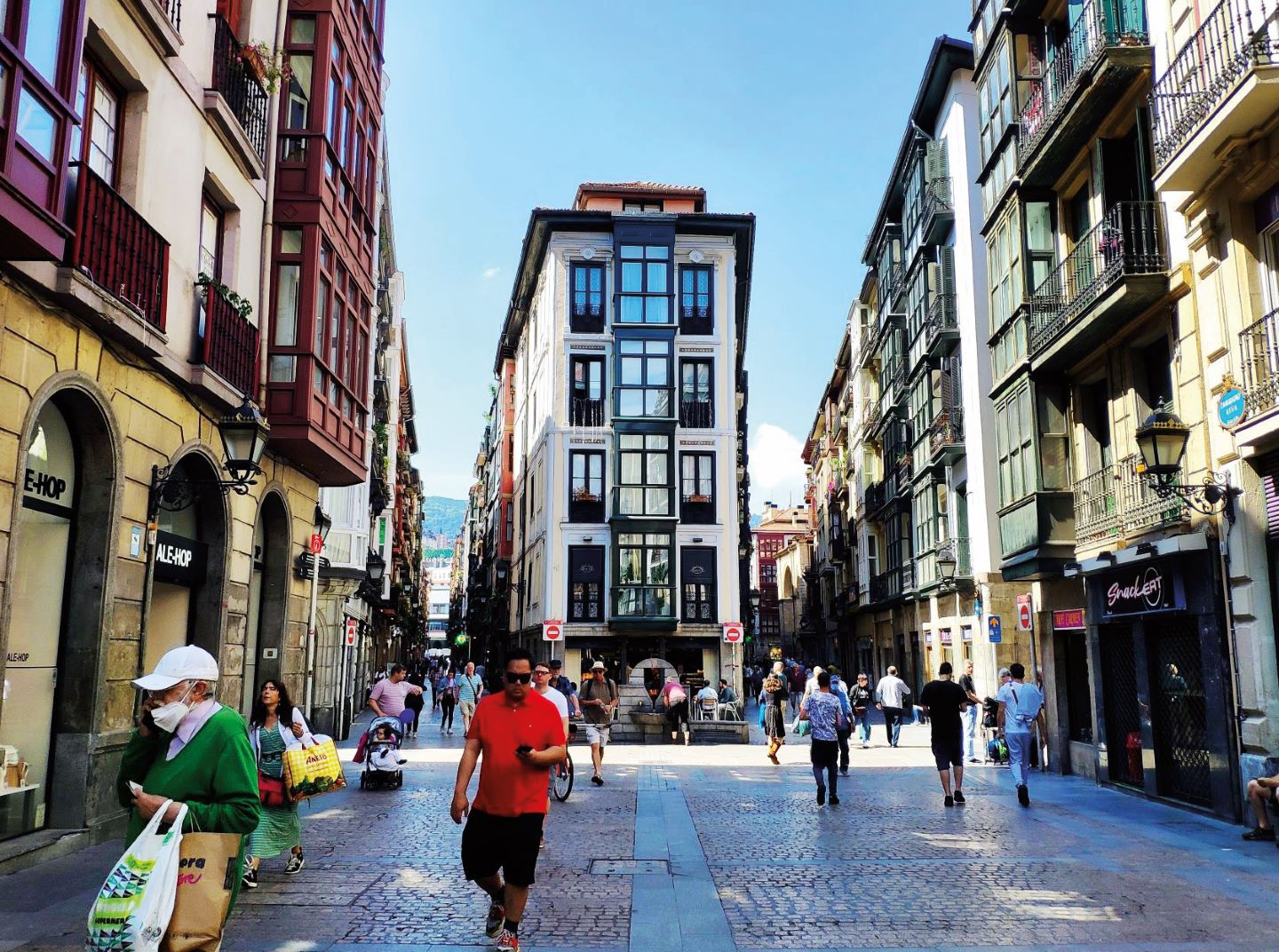
The Casa Viejo is said to have started in this section of the old quarter (All photos: Lee Yu Kit)
The cities of Bilbao and San Sebastián in Spain, with a distance of about 100km between them, have always had a friendly rivalry. My informal city walking guide gave three reasons Bilbao comes up on top, from her perspective. It is less expensive to live in, rains less (both cities have rainy weather, but Bilbao less so), and it has more desserts to call its own (the three desserts traditionally associated with Bilbao are Carolinas, custard rice cakes and butter sweet rolls).
Both cities have a strong identity, being part of the Basque Country, an autonomous community. The history of the Basque people is one of fierce independence, oppression and struggle. The Franco regime in Spain violently oppressed the Basque community during the 20th century. One of Pablo Picasso’s best-known works, Guernica, painted in 1937, was inspired by the bombing of the Basque city in that same year, during the Spanish Civil War.
The Basque identity staged a revival in the late 20th century, with the language now taught in schools. The language is unique, unlike anything else in Europe and thought to be ancient.
Bilbao today is associated with style and the sheen of glamour spearheaded by its single most identifying landmark. It is not too much of a stretch to say that the Bilbao Guggenheim Museum has done more to transform the city and its image than anything else. This is the so-called “Guggenheim effect” or “Bilbao effect”, often since imitated elsewhere but never with the same success. The idea that iconic architecture can polish a city’s image and transform it in the public eye has birthed ambitious building projects globally, many of them museums. Count among these Shanghai city’s Museum of Astronomy; the Luna Foundation in Arles, France; the Dundee Victoria and Albert Museum in the UK; and the United Arab Emirates’ Museum of the Future, among others.
With its beginnings in iron extraction in the 13th century from the ferrous-rich hills around the city, Bilbao grew into an industrial powerhouse, with steelworks and shipyards employing much of the city’s population. A confluence of events led to the precipitous decline of the city’s industrial base.
By the late 20th century, it was a gritty, post-industrial city with the blighted landscape of rusting steelworks and once-bustling docklands. The Bilbao government approached the Guggenheim foundation in 1991 to build a museum in the city, part of a larger redevelopment project to revive the city.
A contest for the art museum was won by American-Canadian architect Frank Gehry. In 1997, the Bilbao Guggenheim Museum was unveiled to the world, to universal acclaim as one of the world’s most spectacular buildings, and a landmark for architecture.
bilbao_guggenheim.jpg
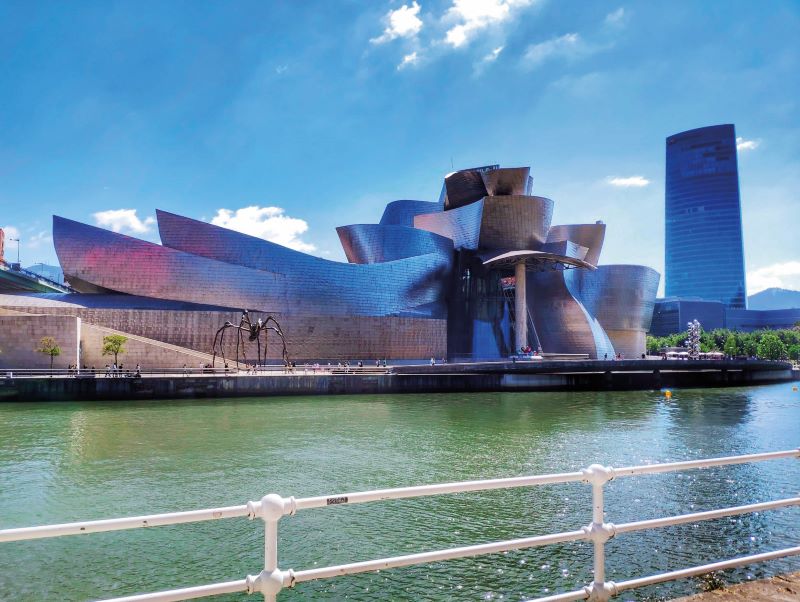
The flowing continuous lines, melding seamlessly into each other, evoke a sailboat, and the iridescent, light-shifting, exterior surface of titanium scales allude to a fish gliding through the water. Both are apt metaphors for the building’s integration into the riverine cityscape on the Estuary of Bilbao. The titanium cladding was chosen for its weather resistance, and weight reduction over other materials, as well as its shimmering appearance. Computer-aided software design (CATIA, which stands for Computer Aided Three-Dimensional Interactive Application) was used to visualise the sensuous curves and twists of the building.
Within the building, a large atrium of twisted glass and limestone scales serves as the “heart” of the building, connecting the floors with light and air. The permanent exhibit, American sculptor Richard Serra’s monumental The Matter of Time, sprawls across a dedicated section on the ground floor.
Outside the museum, away from the river, Jeff Koon’s gigantic, flower-power Puppy greets visitors to the museum. The sculpture was the site of an attempted terror attack during the opening of the museum in 1997; members of the Basque separatist group ETA planted grenades, but the intended attack was foiled by a Spanish policeman, who was shot dead.
bilbao_puppy.jpg
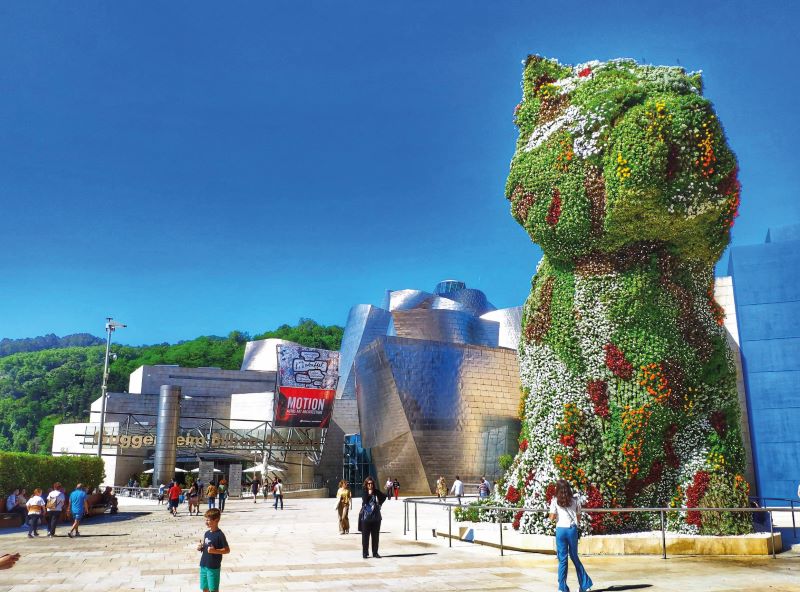
Attracting worldwide attention, the museum became an unqualified success, drawing millions of visitors in the first few years after its opening, and every year since, pumping millions of dollars into the city’s economy. More than the art it displays, the museum has been accused of being too successful, hijacking the focus from the exhibits within the building itself. It has placed Bilbao, better known for random acts of terrorism in the 1980s, on the international tourist map, burnishing the city’s image as one of high style and architecture.
There are other eye-pleasing artworks blended into the cityscape, without having to wander very far. Along the river promenade, which is the best place to view the Guggenheim Museum, a little further upriver is the gracefully curvy Zubizuri Bridge, designed by Spanish architect Santiago Calatrava, while the La Salve Bridge, next to the Guggenheim Museum, provides a contrast to its flowing lines.
Nearby, Philippe Starck’s remaking of the Azkuna Zentroa, a former wine warehouse, and the futuristic Basque Health Department headquarters a few streets away sprinkle stardust to the middle of the city. Even the Norman-Foster designed stations on an extension of the Metro system bring a little glitz to the humdrum event of catching the metro.
It is almost easy to forget that there is the Bilbao of old, the city founded on decidedly unglamourous ironworks that, until recently, was Bilbao city. The best place to glimpse this contrast is further upstream on the right-hand side of a curve of the Estuary of Bilbao, where nestles Casa Viejo, the walled old town where it all began.
bilbao_zubzuri.jpg
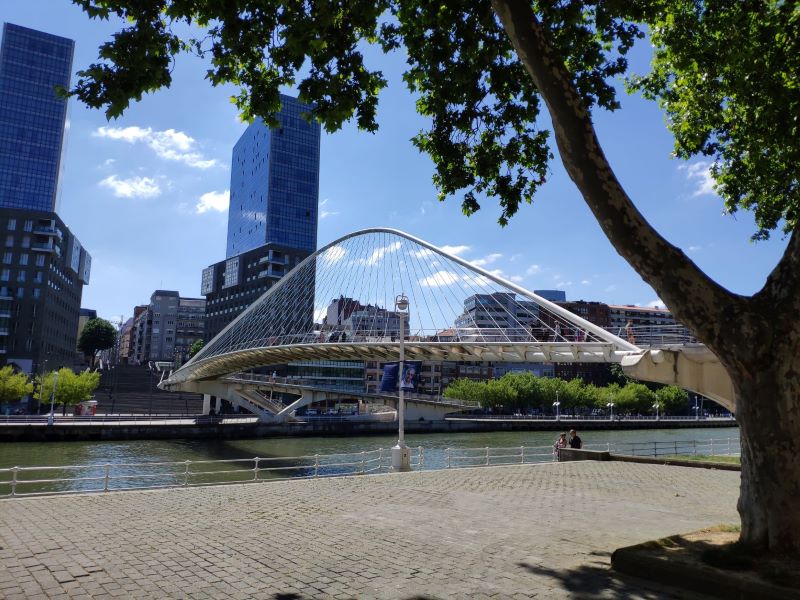
The old quarter is a phalanx of tall stone buildings penetrated by narrow, pedestrian-only streets, which are in turn connected by even narrower alleys. People live in the old city as they always have, ground floors being occupied by shops, businesses and restaurants, while residents live upstairs. Only a small section of the original 13th century wall exists; renovations, rebuilding and flooding have reshaped Casa Viejo to what it is today, a thriving once-walled city within a city.
A few tourist souvenir shops are peppered around the old quarter but, by and large, Casa Viejo is authentic. You encounter the commerce of a city at work; deliveries to shops; residents going about their tasks; small, grimy grocery shops; and the lingering smell of cigarette smoke in the alleys.
A few grand stone churches grace the old quarter, including the 14th century Cathedral of Santiago, the oldest church in the city. On the outside wall of St Nicholas’ church is a high-level marker for the flood waters of 1983, almost double a person’s height.
The origins of the city are the Seven Streets, deep in the heart of Casa Viejo. Streets open out into open plazas. The Plaza Nueva is one of these, with colonnaded archways with shops and restaurants surrounding a wide sunny square. It dates to the mid-19th century, and reflects the social mores of the time in the four-tiered building around the square. Balconies and windows become progressively smaller on the higher floors, where the rents were cheaper and the less affluent lived.
bilbao_nueva.jpg
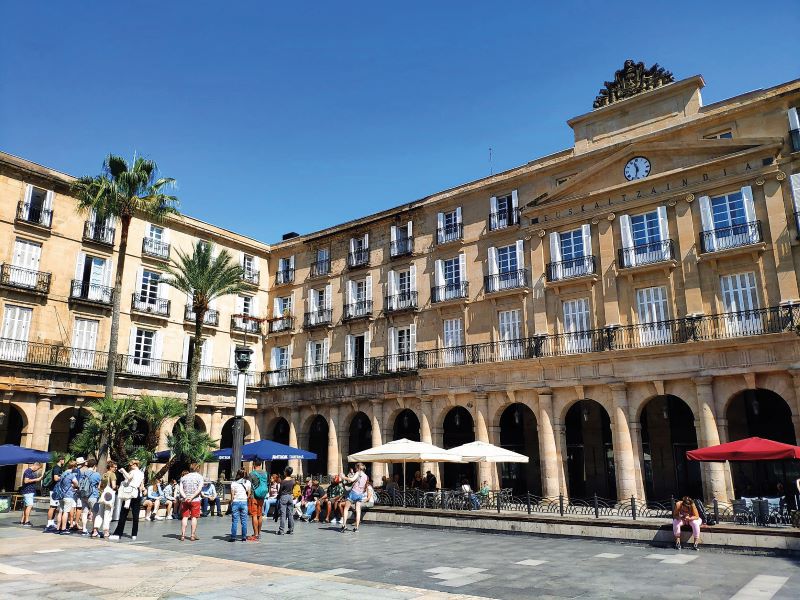
At the periphery of the old quarter, beside the river, another landmark is the graceful Arriaga Theatre, opened in 1902. It mixes various architectural styles and is the city’s main theatre, holding shows and programmes. Like many of the buildings in the old town, it was damaged in the flooding of 1983.
At the other end of the old quarter, by the river, is the art-deco style Mercado de La Ribera, the largest covered market in Europe. The morning is the best time to visit the many stalls selling fresh produce but, even later in the day, there is a thriving, bustling gastrobar section with vendors specialising in pintxos.
Pintxos are a characteristic of Basque culture. Like tapas, but smaller, they are informal bar food usually taken with beer and in company. A bit of ham and cheese, fish, octopus and egg skewered onto a slice of bread is a pintxo. Bars also offer mini-sandwiches, mussels in spicy sauce, squid in black ink, potato and egg side dishes, bacalao (salted cod) and so on. A few of these, a few beers, move onto the next stall, a few more, and the appetite for dinner is ruined.
bilbao_mercado.jpg
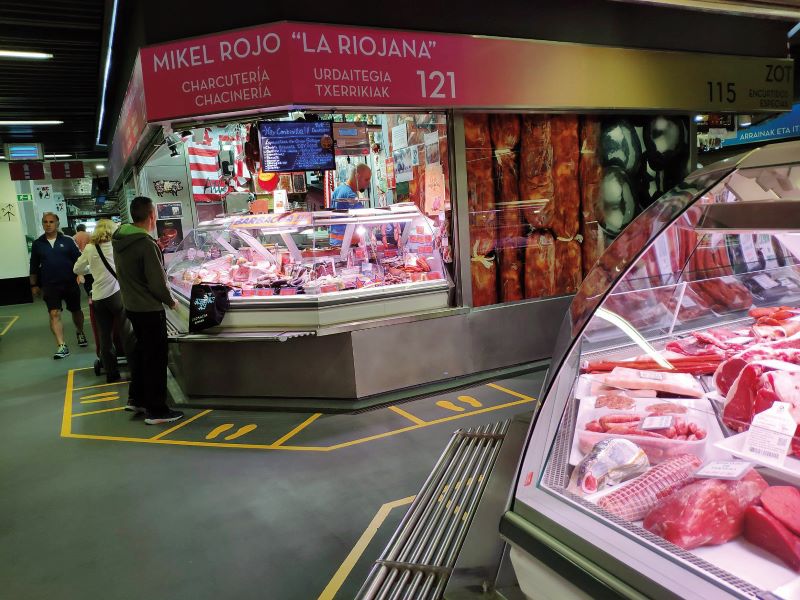
Formal restaurants with kitchens typically take a late afternoon break, reopening for dinner around 8pm or later, but pintxos, much like tapas, are available even at odd hours as they require no cooking, although some pintxos are served hot by being tossed for a few minutes in the oven.
There is a family-run restaurant in Casa Viejo that has been serving traditional Basque food since 1959, including cazuelitas, which are stews served bubbling hot in clay ramekins, with such items as snails, “beef face”, “pork feet”, “lamb insides”, quail, squid in black ink sauce, rabbit and tripe stews. For a break from pintxos and generic food, it is a refreshing find, a reminder of the sturdy Basque character underlying the glamour and glitz of Bilbao.
This article first appeared on Feb 27, 2023 in The Edge Malaysia.


